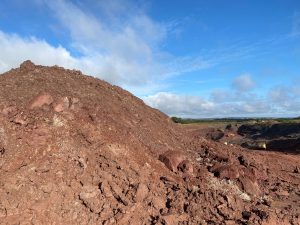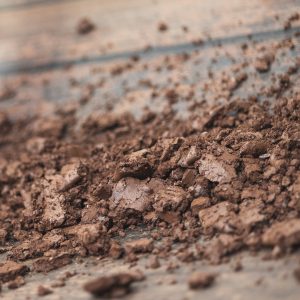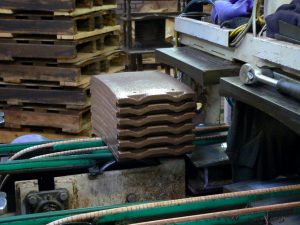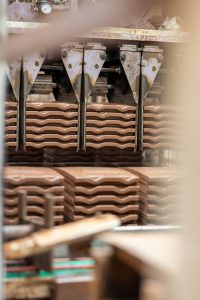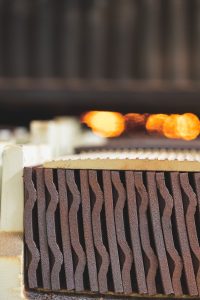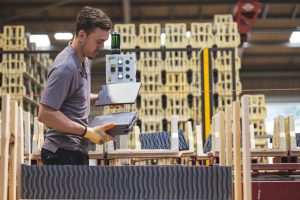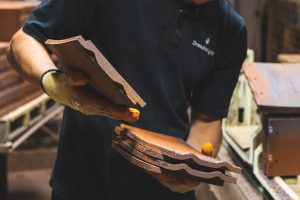CLAY ROOF TILE MAKING – THE DREADNOUGHT WAY
Clay roof tile making is thought to have been first introduced to Britain by the Romans in the 1st century AD.
Although the basic principles of firing clay products have remained the same, the old way of traditional hand making has largely been replaced over the years by highly sophisticated automated processes that now ensure a superior and more consistent quality and appearance.
Since it was founded in 1805, Dreadnought has been part of centuries of manufacturing evolution and today combines the very best of historic craftsmanship with modern technologies and innovation to produce tiles of immense quality and character.
The Quarry
The whole manufacturing process starts at the quarry, where the quality and type of clay available is critical.
Unlike some of today’s manufacturers, Dreadnought still has its own quarry of high-quality Etruria Marl clay, near to the factory. As it is a very dense clay, Etruria Marl is particularly suited to the manufacture of roof tiles and its high iron content, when fired at high temperatures, produces our much sought-after natural Staffordshire clay colours.
In its raw state, the clay can be variable so to ensure consistency stockpiles are built in layers, and the minerology of each layer is tested, particularly the silica content, so that any unwanted material can be removed before preparation and processing.
Clay Preparation
The purpose of the preparation stage is to deliver clay to our extruders in as consistent a form as possible. This is a complex process carried out over 24 hours.
First the clay is fed into a crusher, then transferred into a large mechanical wet pan where water is added, and large rollers push the raw clay through slots in the grid plates. From the wet pan the milled clay is fed into high-speed rollers for the first of two sizing operations. This is followed by a further set of rollers to reduce the clay into particles of the right size, consistency, and overall moisture content.
The mixed clay is then laid in a silo to cure and settle for a day before going on to the tile extrusion section.
The Extrusion
After the preparation stage, the ground clay is fed into mixers then de-airing extruders, where the particles are forced under high pressure through a die to produce long solid bats of clay.
This extruded strip then goes through a ‘nibber’ where the nibs and holes are added, and the clay bat is sliced into nine individual tiles, with circular blades. A ‘cricker’ adds a camber or curve to the individual tiles.
At Dreadnought this extrusion process delivers about 6,000 machine made tiles an hour, which are stacked by a robot into ‘bungs’ of 12 tiles and then placed on pallets ready for transport into the drying chambers.
The Drying
Drying is a very gradual process which currently takes 184 hours (7 ½ days) for standard plain tiles and about 14 days for larger tiles such as gable tiles.
It is vitally important that the tiles dry slowly so that the inside becomes dry before the outside skin, because if any moisture is left in the tiles they may distort or crack in the kiln.
At Dreadnought we have six drying chambers running 24/7, each with a capacity for 46,080 tiles. Once the tiles are completely dry, they are ready to be set on the kiln cars ready for the kiln.
Kiln firing
At Dreadnought we run five energy efficient computer-controlled kilns: shuttle kilns, specials kilns and a tunnel kiln which runs continually around the clock.
The tiles are first pre-heated up to 140 degrees to avoid thermal shock before the firing begins then, once the firing process starts, the temperature is gradually ramped up to 1130 degrees followed by an extensive dwell time.
We are the only machine-made tile manufacturer to set all our tiles on edge and this is still done by hand as a ‘open set’ rather than by a robot. The small space between each tile, created by the nib, allows the kiln atmosphere to circulate naturally around all the surfaces of each and every tile.
Unlike other manufacturers, who use artificial pigments and stains, all our natural colours are achieved organically, the traditional way, by adjusting the temperature and the amount of oxygen within the kiln atmosphere.
An oxidising atmosphere produces reds and a hybrid atmosphere with limited reduction in oxygen produces brindle tones. A longer and more intense period of reduction converts the iron content in the clay to produce the darker Staffordshire blues for which Dreadnought is renowned.
Kiln burners, who load and unload each kiln, constantly monitor both temperatures and pressures to ensure that we get the right firing mix for the type of product we are making.
Then, once the tiles come out of the kiln, they are gradually cooled to 100 degrees. This whole process takes approximately 100 hours: two days firing and then two days cooling.
Quality control
Once cool, the tiles are sorted by hand. As quality is paramount, every tile is handled and examined by our team of eight sorters, who check the colour and for any small cracks or irregularities. The tiles are then loaded onto pallets ready to be dispatched to our customers.
Exciting new developments
As a company, we are constantly evolving and improving our processes to meet the changing needs of todays and tomorrow’s markets.
As we move towards a zero-carbon economy, we are implementing firing efficiencies and are looking at capturing surplus heat from the kilns to feed the dryers, which should reduce our gas requirements by 10%.
The company has already cut its emissions by 29% since the start of CO2 measurements in 2008 and is looking into all technologies, once our energy efficiency projects have been completed, to get us to Nett Zero. Ultimately, we see carbon capture attached to the flue exhaust gases as the solution that will enable Nett Zero to be achieved.
As one of the oldest clay roof tile manufacturers, we remain in the forefront of innovation and change as we move towards more energy efficient and sustainable production and a cleaner, greener society.

